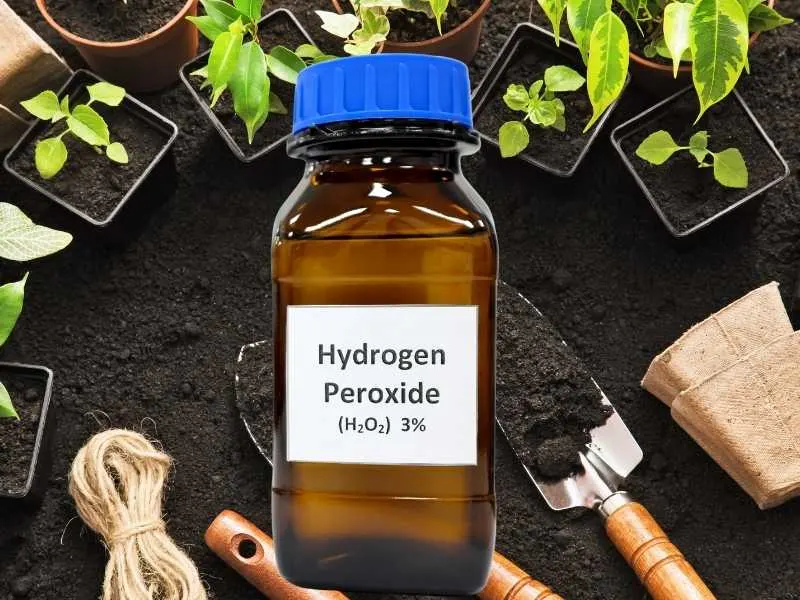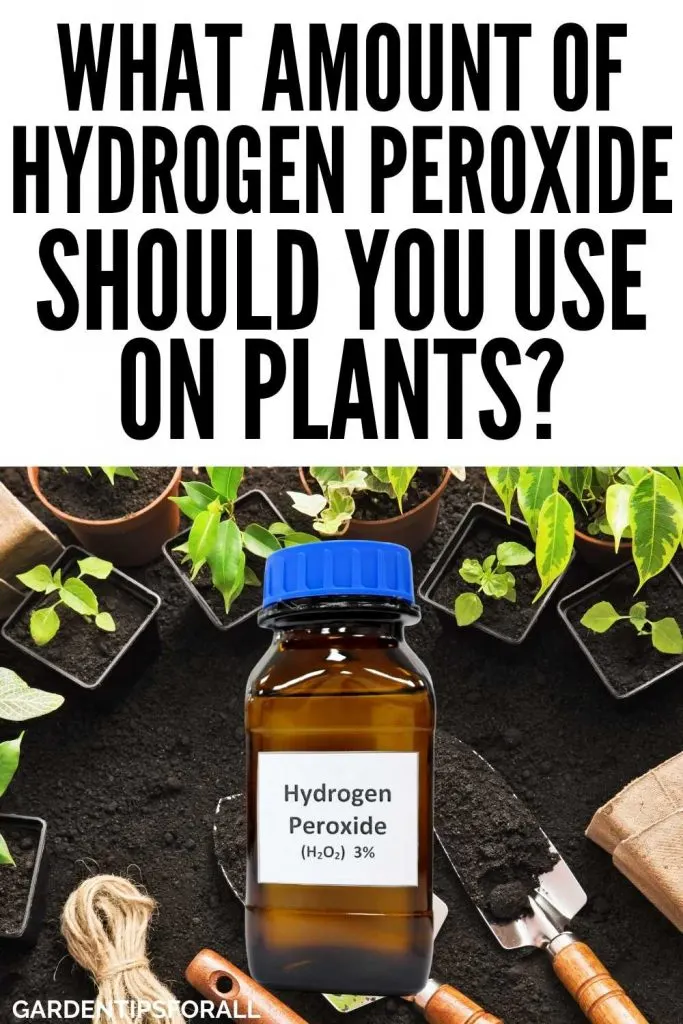How Much Hydrogen Peroxide for Plants Should You Use?
Do you have some hydrogen peroxide sitting in your cabinet that you are planning to use on your plants, but are wondering what quantity of hydrogen peroxide to use on your plants?
Hydrogen peroxide has many benefits for your garden; however, it is essential to understand the amount to use before using it because too much of the chemical might damage your plants.
On the other hand, you might not get the best results if you do not apply enough. So, how much hydrogen peroxide for plants should you use?

The ideal amount is half a cup of the 3% solution in every gallon of water and 2 teaspoons of the 35% solution per gallon of water.
Before going into detail on how much hydrogen peroxide to use on plants, let’s first discuss the benefits of hydrogen peroxide for plants.
The Uses of Hydrogen Peroxide in Plants
Oxygenation and Prevention of Root Decay
The roots of your plants stand to suffer from oxygen shortage if you overwater them. The excess water takes the place of oxygen in the soil, and the roots end up suffocating.
This further leads to the withering of your plants. However, you can avoid this by adding small amounts of hydrogen peroxide to the water. This will ensure that the roots have enough oxygen, preventing rot.
Hydrogen peroxide also helps to remove impurities found in the water to make it safe for your plants.
Seed Sanitization
If you have a seedbed, then hydrogen peroxide should be your new best friend. It comes in handy for the seeds by killing some pathogens that might be found in them.
Such pathogens might cause the seedlings to die before they start growing. However, if you soak your seeds in hydrogen peroxide of 3% concentration for five minutes, the pathogens will die, and you can be sure to have the seedlings grow into plants.
Plant Fertilizer
Hydrogen peroxide is an excellent plant fertilizer, and it will significantly strengthen the roots of your plants.
Some portions of oxygen in this chemical reinforce the absorption of essential nutrients and minerals from the soil.
All you need to do is mix the hydrogen peroxide with water very well and pour the mixture into the ground (your garden).
Disinfecting Plant Pots, Tools, and Greenhouses
Sometimes germs hide in the containers in which you planted your plants. They might spread to your plants eventually and affect them.
Also, the tools you use in your garden might have some harmful microorganisms that might harm your plants.
You can use hydrogen peroxide to disinfect the pots, greenhouses, and tools that you use. A concentration of 7 to 9% would be ideal for the task.
Weeds Control
Hydrogen peroxide is a well-known weed killer. So, if you have some stubborn weeds in your garden or lawn, you can use hydrogen peroxide to fight them.
Pest Control
In case you didn’t know. A Lot of pesticides contain hydrogen peroxide. But can you use it on its own to kill insects and their eggs? Yes, you can.
However, it may not be very effective with all insects, but it’s better than nothing. 3% and 5% solutions will work as a repellent and insect killer.
But don’t use any concentration advertised to be more than 35% since that will burn your plants.
Fighting Fungus
A study published in the International Journal of Horticultural Science shows that Hydrogen Peroxide is a useful fungicide and is helpful in preventing or slowing down the effects of powdery mildew in cucumber plants.
Another study showed that spraying hydrogen peroxide on pepper initiates a defense mechanism against pepper golden mosaic geminivirus (PepGMV).
How Much Hydrogen Peroxide for Plants to Use
Now that you know why you need to use hydrogen peroxide on your plants, it’s time to know the right amount to use, so you get the best results. Any concentration of the chemical exceeding 10% will kill your plants. This is why you should dilute it before using it on plants. This reduces the concentration, helping to reduce any adverse effects on the plant.
There are two variants of hydrogen peroxide: One has a concentration of 3%, and the other has a 35% concentration.
The 3% one is widely available at the drug stores, and it’s the best for small gardens. However, you must dilute both variants. On the other hand, the 35% concentration is the best to use on big farms.
How Much Hydrogen Peroxide Per Gallon of Water for Plants?
It all depends on the peroxide variant/concentration. Experts recommend using 1 teaspoon 3% hydrogen peroxide for 1 gallon of water and 1/2 teaspoon of 35% hydrogen peroxide for 1 gallon of water.
How to Apply Hydrogen Peroxide and the Dilution Ratio
There are two ways of using this chemical, and here is a discussion of each.
1. Spraying
This method is best used on plants that are infected by fungus. If you use the hydrogen peroxide with a 3% concentration, you should dilute it using this ratio.
- One tablespoon for 1 cup of water
- Two tablespoons for 1 pint of water
- ¼ cup for 1 quart of water
- 1 cup for 1 gallon of water
- 10 cups for 10 gallons of water
Here is the ratio to use for the 35% concentrated hydrogen peroxide.
- ¼ teaspoon for 1 cup of water
- ½ teaspoon for 1 quart of water
- 1 teaspoon for a quart of water
- 1 tablespoon for 1 gallon of water
- 6 tablespoons for 5 gallons of water
2. Watering Plants
Here is the ratio to follow when using the 3% concentration of the peroxide:
- 1 tablespoon for 1 cup of water
- 2 tablespoons for 1 quart of water
- ½ cup for 1 gallon of water
- 2 cups of for 5 gallons of water
On the other hand, if you are using the 35% concentrated hydrogen peroxide, follow this ratio:
- A cup of water for 10 drops of hydrogen peroxide
- ½ teaspoon for 1 water gallon
- 3 tablespoons for for 5 water gallons
- 6 tablespoons for 10 water gallons
- 1 tablespoon for 20 gallons of water.
What are the Precautions to Take When Diluting Hydrogen Peroxide for Plants?
- Always add water to the peroxide when diluting. This is because it contains higher levels of oxide, which makes it acidic.
- Use the recommended amount of water to dilute the chemical.
- Always wear gloves to protect your skin.
- Ensure you add more water than the hydrogen peroxide solution.
How Often Can You Spray Hydrogen Peroxide on Plants?
You can spray hydrogen peroxide on plants. Watering your plants with hydrogen peroxide at least once a week can help them stay in better shape. Some people also spray after it rains, which also works.
Conclusion
Your garden stands to gain much with hydrogen peroxide. However, remember that it’s a chemical and be cautious when using it on your plants.
Also, be sure to dilute it according to the recommended concentrations. This article has discussed the right amount of hydrogen peroxide that you should use on your plants. But the amounts for each benefit may differ, and you may have to try different concentrations to achieve the desired results.

